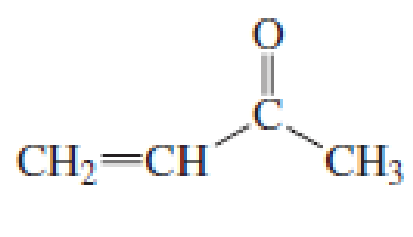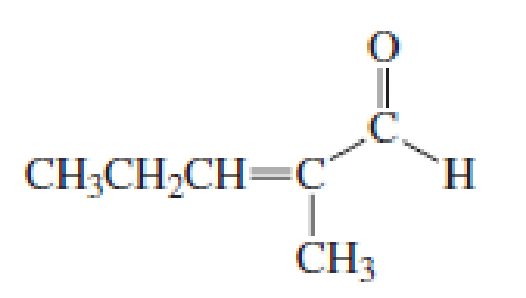
Essential Organic Chemistry (3rd Edition)
3rd Edition
ISBN: 9780321937711
Author: Paula Yurkanis Bruice
Publisher: PEARSON
expand_more
expand_more
format_list_bulleted
Concept explainers
Textbook Question
Chapter 13, Problem 45P
Describe how the following compounds can be synthesized using reagents that contain no more than three carbons:


Expert Solution & Answer
Want to see the full answer?
Check out a sample textbook solution
Students have asked these similar questions
What product is formed when each compound is treated with K 2Cr 2O 7? With some compounds, no reaction occurs.
Explain how 1-butanol can be converted into the following compounds:
Describe how 1-ethylcyclohexanol can be prepared from cyclohexane. You can use any inorganic reagents, any solvents, and any organic reagents as long as they contain no more than two carbons.
Chapter 13 Solutions
Essential Organic Chemistry (3rd Edition)
Ch. 13.1 - Identify the most acidic hydrogen in each...Ch. 13.1 - Prob. 2PCh. 13.1 - Prob. 3PCh. 13.1 - Prob. 4PCh. 13.1 - Explain why HO cannot remove a proton from the...Ch. 13.2 - Prob. 6PCh. 13.2 - Prob. 7PCh. 13.3 - Prob. 8PCh. 13.3 - Prob. 9PCh. 13.3 - Prob. 10P
Ch. 13.4 - Prob. 11PCh. 13.5 - Prob. 12PCh. 13.5 - Prob. 13PCh. 13.6 - Prob. 14PCh. 13.7 - Prob. 16PCh. 13.8 - Prob. 17PCh. 13.8 - Prob. 18PCh. 13.8 - Prob. 19PCh. 13.9 - Prob. 20PCh. 13.10 - Propose a mechanism for the formation of...Ch. 13.10 - Prob. 22PCh. 13.10 - a. If the biosynthesis of palmitic acid were...Ch. 13 - Draw the enol tautomers for each of the following...Ch. 13 - Number the following compounds in order from...Ch. 13 - Prob. 26PCh. 13 - Explain why the pKa of a hydrogen bonded to the...Ch. 13 - Prob. 28PCh. 13 - Prob. 29PCh. 13 - Prob. 30PCh. 13 - Prob. 31PCh. 13 - Prob. 32PCh. 13 - Prob. 33PCh. 13 - Using cyclopentanone as the reactant, show the...Ch. 13 - Prob. 35PCh. 13 - Prob. 36PCh. 13 - Prob. 37PCh. 13 - Prob. 38PCh. 13 - Prob. 39PCh. 13 - Prob. 40PCh. 13 - Prob. 41PCh. 13 - Prob. 42PCh. 13 - Prob. 43PCh. 13 - Prob. 44PCh. 13 - Describe how the following compounds can be...Ch. 13 - Prob. 46PCh. 13 - Which would require a higher temperature:...Ch. 13 - Prob. 48PCh. 13 - Propose a mechanism for the following reaction:Ch. 13 - Show how the following compounds could be...Ch. 13 - Prob. 51PCh. 13 - Prob. 52P
Knowledge Booster
Learn more about
Need a deep-dive on the concept behind this application? Look no further. Learn more about this topic, chemistry and related others by exploring similar questions and additional content below.Similar questions
- Using the given starting material, any necessary inorganic reagents and catalysts, and any carbon-containing compounds with no more than two carbons, indicate how each of the following compounds can be prepared:arrow_forwardDescribe how the following compound can be synthesized from compounds containing no more than six carbonsarrow_forwardUsing the given starting material, any necessary inorganic reagents and catalysts, and any carbon-containing compounds with no more than three carbons, indicate how each of the following compounds can be prepared:arrow_forward
- Name the following compound; CH3 CH₂CHCHCH₂CH₂CH₂CHCH₂CH3 O 3-Methyl-8-propylnon-1-ene O 7-Ethyl-3-methyldec-1-ene O 8-Methyl-2-propylnonane O 8-Methyl-2-propylnon-1-ene CH₂CH₂CH3arrow_forwardUsing the given starting material and any necessary organic or inorganic reagents, indicate how the desired compounds could be synthesized:arrow_forwardName and draw the structure of the major product in the following reactions of cyclohexanone: A) Reduction with NaBH4 in ethanol, followed by H+ B) Reaction with excess ethanol in the presence of H+arrow_forward
- What alkene is needed to synthesize each 1,2-diol using [1] OsO4 followed by NaHSO3 in H2O; or [2] CH3CO3H followed by −OH in H2O?arrow_forwardSorbitol is a sweetener often used in chewing gum and diet drinks. It is obtained by the following reaction. Which of the following functional group transformations occur during this reaction? СНО CH2OH Н-с-ОН Н-с-ОН Но-с-н Н2 Но-с-н Н-с-ОН Н-с-оН Н-с-ОН н-с-он CH2OH CH-Он glucose sorbitol a. The aldehyde becomes an alcohol. b. An alcohol becomes an aldehyde. c. An alcohol disappears. d. A new aldehyde appears. e. All of the abovearrow_forwardRank the following alcohols in order of increasing ease of acid-catalyzed dehydration. Provide the structure of the dehydration product (alkene) from each alcohol. OH OH 3 1 a OHarrow_forward
- Alcohols undergo dehydration reactions in the presence of an acid catalyst. Which of the following compounds yields only a single alkene product upon dehydration?arrow_forwardHow could the following compounds be prepared, using cyclohexene as a starting material?arrow_forwardAn alkene with the molecular formula C10H18is treated with ozone and then with zinc and acetic acid. The only product isolated from these reactions is: What is the structure of the alkene? I O III OV O IV ΟΙ IV II Varrow_forward
arrow_back_ios
SEE MORE QUESTIONS
arrow_forward_ios
Recommended textbooks for you

How to Design a Total Synthesis; Author: Chemistry Unleashed;https://www.youtube.com/watch?v=9jRfAJJO7mM;License: Standard YouTube License, CC-BY